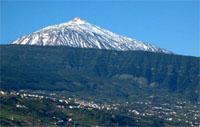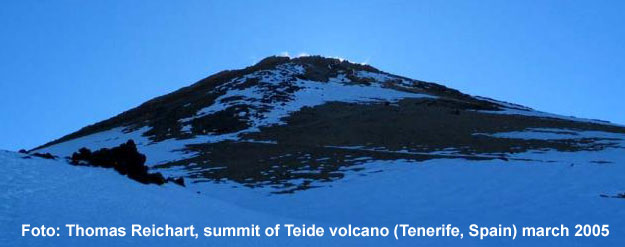| News from Teide (Tenerife, Canary Islands, Spain) |
 |
|
Bulletin of the Global Volcanism Network
Volume 31, Number 2, February 2006 |
|
|
Tenerife (Canary Islands) 2004 seismic crisis;
January 2005 escalation in monitored
parameters at Teide |
|
 |
|
|
Juan Carlos Carracedo notified Bulletin editors that seismic activity
in Tenerife during April and May 2004 was not followed by any volcanic
activity. More than 200 earthquakes from magnitude 1 to 3 were recorded,
but residents felt only three of them. Most of the epicenters were localized
around the NW rift zone of Tenerife and in the strait between Gran Canaria
and Tenerife. The crisis was probably related to dike emplacement at
3-4 km depth.
Background. The large triangular island of Tenerife is composed of
a complex of overlapping Miocene-to-Quaternary stratovolcanoes that
have remained active into historical time. The NE-trending Cordillera
Dorsal volcanic massif joins the Las Cañadas volcano
on the SW side of Tenerife with older volcanoes, creating the largest
volcanic complex of the Canary Islands. Controversy surrounds the formation
of the dramatic 10 x 17 km Las Canadas caldera, which is partially filled
by 3715-m-high Teide stratovolcano, the highest peak in the Atlantic
Ocean. The origin of the caldera has been considered to be due entirely
or in part to either a massive landslide (in a manner similar to the
earlier formation of the massive La Orotava and Guimar valleys in the
Cordillera Dorsal) or due to major explosive eruptions. The most recent
stage of activity beginning in the late Pleistocene included the construction
of the Pico Viejo and Teide edifices. Tenerife was perhaps observed
in eruption by Christopher Columbus, and several flank vents on the
Canary Island's most active volcano have been active during historical
time. Information Contacts: Juan Carlos Carracedo, Estacion Volcanologica
de |
|
 |
|